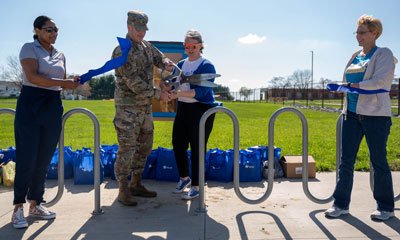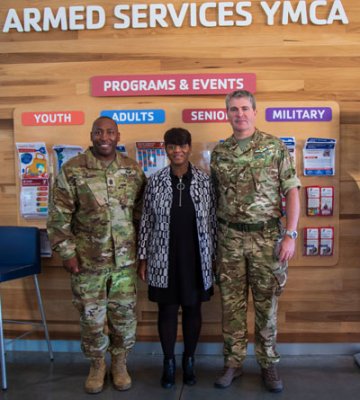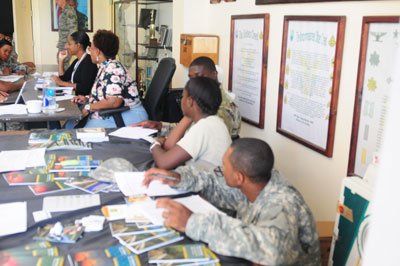Veterans Who Are Food Insecure Are Less Likely to Seek Help Than Civilians
About eight years ago, Carl Davis stared at his bills and decided which ones not to pay. Without the financial jigsaw, he couldn’t afford food for his family. Davis, who has a 100% disability rating from Veterans Affairs for service-related injuries to his wrist and lower back, relies on his VA compensation for income.
As he struggled, his longtime partner was also out of work after she hurt herself on the job at a college dining facility. With three kids under one roof, they were stretched beyond their means.
Davis’ sister told him about the Feed Our Vets food pantry near his upstate New York home. Initially, the Army vet was reluctant to seek help, but when he learned a veteran founded the food pantry for veterans, it put him at ease. He’s been going ever since.
“It’s not just a food bank,” he says. “We all talk the same language. I like to say we’re all brothers from another mother, at this point.”

U.S. Air Force Col. Chris Robinson, 375th Air Mobility Wing commander, and Alicia Steele, Spark Adolescent Resources president, cut a ribbon during a ceremony on Scott Air Force Base, Illinois, April 3, 2023. On-base families have access to the blessing box, made to provide free nonperishable food items and household goods to combat food insecurity. Photo by Airman 1st Class Shelby Rapert, courtesy of the U.S. Air Force.
During Davis’ visits to the food pantry, he’s met veterans who fought in Vietnam, Korea, Desert Storm, and the post-9/11 wars, some of whom struggle far more than his own family does to afford meals. While this group of vets is comfortable stocking up on food at the Feed Our Vets pantry, many of them, Davis says, avoid signing up for the Supplemental Nutrition Assistance Program—the federal nutrition program formerly known as food stamps.
“Some are too prideful and some don’t want to go that route,” Davis says. Others may not qualify. The VA benefits Davis receives, for instance, count as income and make him ineligible.
Davis’ observations bear out in a recent RAND report that found veterans who are eligible for SNAP are less likely to participate in the program than their nonveteran counterparts.
Food insecurity—the inability to secure enough food to maintain health—can involve relying on cheap, unhealthy food. Adjusting for a range of characteristics, including age, the RAND report states that veteran status was associated with a 7.4% increased likelihood of living in a household with food insecurity, and a 9.2% increased likelihood of being very food insecure, which means regularly skipping meals. Among food-insecure veterans aged 70 and older, only 29% were likely enrolled in SNAP, compared with 39% of their nonveteran counterparts. Among food insecure veterans who are not working because of a disability, about 45% are likely enrolled in SNAP, compared with 54% of similarly disabled food-insecure nonveterans.
In a 2020 congressional hearing, Dr. Thomas O’Toole, who was then the Veterans Health Administration senior medical adviser but is now the Deputy Undersecretary of Health, explained the significant consequences of food insecurity: “Research has consistently shown the link between lacking regular access to food and poorly controlled hypertension, diabetes, HIV disease, asthma, depression, anxiety,” he said. “Among older adults, it is associated with reduced activities of daily living and being over two times more likely to report poor health.”
Even more concerning, particularly for VA, which has made preventing veteran suicide its top clinical priority, is the link between food insecurity and suicidal ideation. In a survey of more than 1,000 randomly chosen post-9/11 veterans across all branches, those who reported food insecurity had nearly four times higher levels of suicidal ideation when surveyed one year later than veterans who did not struggle with accessing food, a report released earlier this year showed. In 2020, 6,146 veterans died by suicide, according to the most recent National Veteran Suicide Report. On average, that’s nearly 17 deaths per day. And while rates have improved since 2018, they’re still 57% higher than the nonveteran population.
‘You Might Feel More Reluctant to Seek Help’
Overall, the rate of food insecurity among veterans is lower than nonveterans, Rand found. But the group estimates that 1.4 million veterans are food insecure. Younger veterans with families, women, low-income veterans, and those with underlying depression or psychiatric illness are all at more risk to experience it.
“In one study, 27% of Iraq and Afghanistan war veterans reported food insecurity,” O’Toole said during the 2020 congressional hearing. “In another, 48.5% of homeless and formerly homeless veterans lacked regular access to food.”
States administer SNAP—though it’s a federal nutrition assistance program—and those states can make eligibility and enrollment either easy or cumbersome.
Tamara Dubowitz, senior policy researcher at RAND and one of the authors of the report, says when they analyzed state policies, they found a few were associated with higher SNAP enrollment for both veterans and nonveterans. One includes a “combined application program,” she says. Essentially, if someone applies for a federal benefit like Social Security, that individual automatically applies for SNAP.
And more veterans enroll when they can file paperwork by phone or online, rather than in person.

Sgt. Maj. Calvin Hall, Fort Cavazos garrison command sergeant major (left); Debbie Nash-King, mayor of Killeen, Texas; and Maj. Gen. Michael Keating, III Armored Corps deputy commanding general-support, attend the Harker Heights Armed Services YMCA grand opening for their new “five-star food market” on Oct. 27, 2022. The Harker Heights and Killeen ASYMCA food market aims to help military families who struggle with food insecurity by providing weekly distributions of healthy, fresh food to military families in the area. Photo by Sgt. 1st Class Angela Holtby, courtesy of the U.S. Army.
“Basically, if you live in a state where you have a lot of policies that make it easier, then that helps,” she says. “If you remain in a state that has very few policies, then you’re enrolling at a much lower rate.”
A 2021 RAND report found that Florida and Texas have the highest number of veterans enrolled in SNAP at 116,000 and 97,000, respectively. But that’s because those states have large numbers of veterans, rather than because they have policies that make it easier to enroll, Dubowitz says.
New York and California have tried to simplify SNAP enrollment. A few years ago, when money was tight, Davis looked into enrolling in SNAP. But the pension and disability benefits he receives from VA made him ineligible.
“It all goes by your income, unfortunately,” he says.
States that include VA benefits in income calculations may push veterans who could use the extra help out of the eligibility threshold, Rand found.
“So the food-insecure veterans who are enrolled in SNAP are our most desperate,” Dubowitz says. “They are the food-insecure veterans who are sort of absolutely most in need, but there’s this whole huge group that seem to be getting VA benefits and other benefits that are making them ineligible to enroll in SNAP.”
Income guidelines for determining food assistance eligibility also hit the active-duty military population. Service members receive a basic allowance for housing—a nontaxable entitlement to offset housing costs. Though many federal programs don’t consider this income, SNAP does. Josh Protas, vice president of public policy at MAZON: A Jewish Response to Hunger, a nonprofit working to end food insecurity, says that pushes many low-income, junior enlisted service members with kids out of eligibility.
And he worries that those struggling service members will carry their food insecurity with them after they leave the service.
“If you were a military family that maybe applied for SNAP when you’re in the service, and you were denied, you might feel more reluctant to seek help,” Protas says, “because you’ve had that negative experience.”
‘We Think There’s Real Opportunity’
In 2016, VA established the Ensuring Veteran Food Security Workgroup, which is led by the Veterans Health Administration. Out of this workgroup, VA medical center staff now use a two-question screening tool that aims to capture food-insecure veterans. Staff refer those who screen positive to a dietician and social worker who can help the veteran sign up for SNAP.
VA doesn’t collect data on how many veterans screened positive for food insecurity sign up for SNAP, which hunger advocates would like to see tracked. And VA needs to better evaluate and monitor its efforts to address food insecurity, according to a 2022 Government Accountability Office report. Earlier this year, VA established a Food Security Office that will assist the workgroup with oversight of its activities.
Award-Winning Journalism in Your Inbox
“Our mission is to ensure that all veterans have equitable access to nutritious, affordable, and culturally appropriate food to support veteran whole health,” says a VA spokesperson.
Protas says a better understanding of exactly how VA assists veterans is critical, though, because if they simply hand veterans a SNAP application, the “likelihood that the veteran follows through is pretty small,” he says. The application process should begin instantly, he says: “So eligibility screening, [then] application assistance on site right away—and it’s not clear to what extent that level of intervention happens throughout the system.”

Employees from the Department of Human Services visit Virgin Islands National Guard soldiers at the SFC Leonard B. Francis Readiness Center, Oct.13, 2017. The visit is to assist VING soldiers complete Supplemental Nutrition Assistance Program applications. Photo by Pfc. Leona Hendrickson, courtesy of the Army National Guard.
And there are many veterans who are not VA-connected, Dubowitz says. About half of American veterans get care through VA, and the other half of veterans, who either avoid VA or are not eligible for benefits, will never encounter the food insecurity assessment.
Earlier this year, Congresswoman Jahana Hayes, a Democrat from Connecticut, reintroduced the Feed Hungry Veterans Act. It aims to expand which veterans can be exempted from the work requirements necessary to participate in SNAP. Only veterans with a 100% disability rating qualify for exemption, and the law would lower that threshold to a service-connected disability rating of 60%. The legislation may wind up in this year’s Farm Bill, which is overdue.
In the meantime, Protas says he’d like to see more state SNAP offices partner with veterans service organizations to get out the word.
“There’s been lots of evidence about the power of veteran-to-veteran outreach on a variety of different things, whether it’s suicide prevention or connected to VA benefits,” he says. “We think that there’s a real opportunity to do that.”
Rich Synek, a Navy veteran, founded Feed Our Vets in 2009. The nonprofit has food pantries in New York and Ohio—as well as a grocery gift card program for low-income veterans and their families across the country—and it has distributed more than 3.2 million pounds of food and served thousands of veterans.

Lt. Col. Ryan M. Miedema, 3rd General Support Aviation Battalion commander, helps soldiers unload a large donation to Feed Our Vets in Watertown, New York, 2016. Jeff Cook, president of the board of directors for Feed Our Vets’ Watertown location, said they are a 100% volunteer run organization that serves local veterans in need with food, socialization, and hope. Photo by Spc. Thomas Scaggs, courtesy of the U.S. Army.
After nearly 15 years of interacting with veterans who struggle to afford food, Synek says pride keeps many from enrolling in SNAP, as well as the mentality ingrained in the military that they can survive anything, and that others need the help more than they do.
“We find that at the pantry—that ‘I won’t take as much because somebody else is worse off than me,’” he says. “We have people from SNAP who come down and try to register at events. You do hear a lot of them say, ‘No. I don’t need it.’”
Researchers weren’t able to definitively conclude why veterans, particularly older veterans, may be especially resistant to SNAP, but it’s likely tied to generational differences, Dubowitz says.
“There might be a stigma attached to not only the use of SNAP, formerly known as food stamps, but any other safety net programs,” she says. The abundant paperwork around applying to SNAP can also become a hurdle. “Enrolling and navigating the system around these programs is not easy, especially if you’re older and not necessarily computer literate.”
Our Journalism Depends on Your Support
The first veteran Synek ever assisted was a World War II vet he met while working as a postmaster at a small post office. Occasionally, the small-framed man would shuffle in to buy one stamp, saying that’s all he could afford.
The two would talk about their years in the service, and over time, Syneck learned the man had dropped out of school after eighth grade, got drafted into the war, and worked as a farmhand much of his adult civilian life. He and his wife lived in a trailer. At one point, Synek said something like: “At least you got food in the house.”
The man stayed quiet.
This War Horse feature was reported by Anne Marshall-Chalmers, edited by Kelly Kennedy, fact-checked by Jess Rohan, and copy-edited by Mitchell Hansen-Dewar. Abbie Bennett wrote the headlines.





Comments are closed.